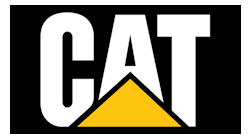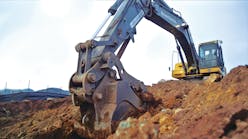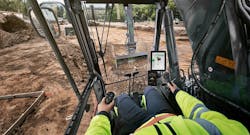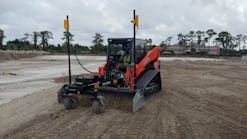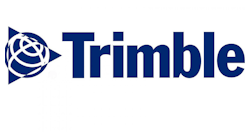Telematics may be defined loosely as the blending of computers and wireless communications technologies, although the contractors who currently employ telematics commonly refer to it as a “GPS system,” which requires a transmitter being attached to equipment to remotely monitor location and other key performance data. Estimates of telematics construction market penetration to this point vary from 3% to 10%. Manufacturers, both OEM and aftermarket, rightfully boast its many benefits—from greater equipment utilization to fuel costs savings, streamlined maintenance management and more. But until recently, its introduction was met with some amount of confusion and frustration. Many obstacles have been knocked from its path since then, making it truly viable for an abrasive and fast-moving construction environment.
Those considering the use of telematics systems are advised to determine what real-world payback they desire and establish a game plan before jumping in. Current users suggest starting with the basics and building from there. Consider the following:
- What specific goals can one achieve from the collection of key data?
- How does one tie reports to desired action?
- How should management react to employees who feel that “big brother is watching?”
- How can data be used to change actual human behaviors to positively affect the bottom line? The last is integral to telematics implementation and is one of the most important issues affecting its success.
We asked a number of providers for their thoughts on the situation as it stand today and the expansion of telematics capabilities and adoption in the future.
Ken Calvert, director of product support systems, Komatsu America Corp.
It’s fair to say that the adoption of telematics has entered the toddler stage. Because it’s common for most North American manufacturers to include a telematics system in the standard machine package, the reporting population base is reaching critical mass. This is causing machine owners to consider its integration into daily operations, leading to an interest in adding devices to legacy machines. Early adopters added telematics to machines more or less as an experiment to improve operations. Second-generation adopters realize telematics is here to stay and have a clear vision of its benefits.
Linking the office to the job site requires that end-users integrate telematics data into business systems, budgeting and planning, and daily decision-making and performance management. This integration needs to happen before machine owners will be able to benefit from a proliferation of features. As an example, when data is placed where it is easily accessed, then managers will check for an underutilized machine prior to ordering a short-term rental. Eventually, I see a time when manufacturers, distributors and machine owners use telematics information to manage performance-based contacts written around criteria such as machine productivity, efficiency, uptime, fuel consumption, and more.
The obvious future is machines streaming real-time CAN-bus data to troubleshoot assets, being able to do remote diagnostics and make embedded software changes on the fly. This is already a reality for certain mining-size machines, and the technology will push down to construction-sized equipment. Technology that is feasible but not yet cost effective will call for maintenance intervals based on results from onboard oil sampling and large-particle analysis. The balancing act isn’t what’s possible but what can be cost-justified in lowering owning and operating costs.
Komatsu’s KOMTRAX technology can be installed on any brand equipment and provide basic location and usage data, which is presented in a way that allows fleet managers to identify if the machine is working where it should be. Once a machine owner installs KOMTRAX on a unit, there are no monthly communication fees or service charges. Secondly, for fleets with mixed telematics, Komatsu provides an industry standard (AEMP) raw-data feed.
Renaat Ver Eecke, vice president and general manager, Navman Wireless, North America
Actual telematics construction market penetration is about 3%. A figure of 5% is inflated, as most of the OEMs are providing the systems as standard on their equipment, which leads to a very limited use of the technology.
Navman Wireless entered the construction market because we saw a void in this critical need and we felt we could address it better than anyone else in the industry. Since we are not an OEM, we are able to empower our customers to track assets across any make, model, and year that they own. Furthermore, since we provide solutions for both on-road and off-road assets, Navman Wireless customers are able to track not only their heavy equipment but also their vehicles. Often times, our customers have two times the number of vehicles as compared to heavy equipment. Thus, the ability to provide one platform to monitor all these assets is a critical value-added that we bring to this market segment.
The two main goals are maintenance and job costing. Remote and real-time capturing of engine hours allows for better planning of maintenance. Furthermore, it reduces costs by preventing over-maintenance of assets, while also decreasing costly downtime. A job-costing functionality allows contractors to allocate in real-time what a job is costing them, enabling them to use that data to improve the bidding on new jobs.
In the future, one could see a predictive management of fault codes coming from the engine. For example, if certain fault codes happen in a certain sequence, a failure could be predicted and sent to the equipment manager, which could possibly prevent catastrophic failures.
Christi Wilson, marketing representative, Caterpillar Inc.
Telematics is quickly becoming a minimum expectation in the industries we serve rather than a luxury or a puzzling techno-gadget. More and more customers are realizing the benefits of remote monitoring.
We noticed a marked change in understanding and demand since ConExpo 2008, when customers were uncomfortable with the technology and couldn’t imagine how it would benefit them. At ConExpo 2011, it was evident the adoption curve had spiked significantly. More customers understand basic asset management features and are anxious to extend its utilization to improve productivity and reduce costs.
Cat Product Link compares machine time in idling versus working. This simplifies the process of reallocating assets to improve productivity and utilization, which in turn reduces unproductive fuel consumption—resulting in higher overall efficiency as measured in material moved per gallon of fuel burned. This timely insight also prevents potential delays in work schedules, or even possible rental needs, by quick identification of machines that are being underutilized.
Also, contractors can identify maintenance and service needs before they become unplanned downtime, and can plan around production schedules.
With operator-generated alerts, Product Link helps the fleet manager spot patterns of harsh operation, which indicates a need for additional operator training. Also, GPS tags on alert help pinpoint site issues such as soft spots or too-steep grades, allowing the quick dispatch of a motor grader, for example, to take other appropriate action that can help improve fuel efficiency and enhance equipment life.
Cat Product Link is as much a part of the modern Cat machine as the engine or transmission. However, this expanded capability is extended to the entire fleet, regardless of make or model, allowing all equipment to be monitored in one secure web-based application eliminating the need to visit different applications with varying functionality. The new VisionLink application from Caterpillar’s partner, Trimble, offers enabling hardware that allows mixed-fleet owners to consolidate machine management efforts.
Steve McGough, chief operating officer, HCSS
When it comes to getting data from the field, time and accuracy are money, and telematics gets accurate information into decision-makers’ hands rapidly. By itself though, it is not a magic bullet. Telematics only takes care of gathering the information. In order for that information to be useful, you need an integrated back-office solution that can make sense of all the data.
Specifically, getting run-time hours automatically into your preventive maintenance and job costing systems is a big time saver and prevents over- or under-reporting. Theft alerting is always an issue, and you need a system that will not only text and e-mail but will actually call you when a possible theft might be occurring. Getting text or e-mail alerts for fault codes and speeding is a start, but you also need to use these events to generate alerts or potential work orders for the shop. You could also be using GPS information along with job and site information to automate your billing and to verify truck deliveries.
Currently, the market is really in a “show me” phase where telematics systems just make the data available to equipment managers. Going forward, these systems will move into a “show me where I can save money” phase wherein they will point out manageable areas such as fuel consumption and driver and operator habits. An equipment manager will then be able to benchmark a change and track the resulting cost savings.
Also, getting more intelligent data from the engine and transmission will allow owners to better schedule preventive maintenance work. Instead of a hard and fast rule of 250-, 500-, or 1,000-hour maintenance cycles, owners will be able to run real-time oil and fuel analysis to identify when maintenance needs to be done based on certain machine-level readings. At that point, the machine can also tell the shop what actually needs to be repaired or replaced so the mechanic can have all the parts needed for the day.
Taking an agnostic approach to telematics allows us to apply a solution regardless of make, model or age. HCSS can supply CAN-bus units that read robust data from the latest onboard computers, or we can supply analog devices with switches and relays for even the oldest of cable-operated machines. We then funnel all that data into the same easy-to-use interface so that our customers have one place to go to find the data they need.
Rugged Telematics Alliance (RTA)
Part of the vision behind the Rugged Telematics Alliance, which leverages the experience of a 7-member group of OEMs, is a solution that is taking the critical data coming from machines and extending the value of that data beyond basic remote monitoring or tracking capabilities. With the intelligence built into the solution, data can be repurposed to streamline any number of business processes for job status, planned versus actual hours, emissions validation, HR/payroll, validation of operator credentials, and more. The complexity is in correlating multiple things such as associating an equipment operator with work hours and connecting that to payroll—a complexity made easy by the object modeling capabilities inherent in the solution.
The ability to not only gather data, but to also make sense of the data in a way that is meaningful to its users will enable business model transformation across almost all industries. For example, with real-time visibility into a machine’s activity, a heavy equipment rental company might move to a usage-based pricing model instead of charging a flat rental fee.
The Rugged Telematics Alliance providers leverage available standards to make integration at the hardware and software level of the solution almost invisible to its users. The solution “normalizes” data coming from all different kinds of assets—placing it in a common format so a rule can always be applied in the same way. For example, the platform can make all engine data look similar so that customers can build applications without having to know the details of where the data came from. This enables customers to manage a diverse set of equipment within a single application—allowing them to monitor their entire fleet in one place.
Another advantage is the ease of tailoring thresholds and performance criteria within the applications for alarming or reporting purposes. Once the machines are reporting in, customers can see machine performance data in real-time, manipulate that data, and adjust thresholds or alarm notifications through a straightforward process that doesn’t require programming skills.
Craig Whitney, vice president of marketing, Networkfleet
Because Networkfleet continuously monitors GPS location, it provides reports that can be used to track workers’ time, reducing timesheet and payroll errors; or to locate the vehicle quickly, improving security.
Since Networkfleet connects directly to the vehicle’s engine computer (OBD-II), it monitors engine diagnostics, including fuel usage, idle time and emissions, giving construction managers the ability to reduce fuel expenses and repair costs.
In addition, Networkfleet offers a sensor expansion module (SEM) to give fleet managers access to more vehicle diagnostic data. The SEM detects voltage events from the vehicle, such as Power Take Off (PTO) engagement/ disengagement, secondary engine on/off, and door open/close. Users get detailed reports on sensor activity showing both the duration of events as well as the location of where those events took place. For example, a company can track the use of the “boom” on a cherry picker, or when a street sweeper broom has been engaged.
Telematics continues to evolve toward prognostics—helping to anticipate and fix critical vehicle or equipment issues and avoid costly maintenance costs or failures. These systems will gather more and more data from engines through sensors and then combine that data with predictive statistics to help identify and diagnose potential sources of problems.
Construction companies operate a variety of vehicle types and therefore need a way to track their entire fleet to improve asset utilization. Networkfleet was designed from the start to work with all vehicle classes and types, with the ability to read proprietary diagnostic trouble codes for specific manufacturers on both light and heavy-duty vehicles. We offer devices designed for all types of powered equipment such as bulldozers, scrapers and backhoes. We also offer a battery-powered asset tracker so that contractors can monitor equipment such as generators, trailers, pumps, and heavy-duty machinery, and receive alerts when those assets are moved or certain conditions are changed.
Liz Quinn, product-marketing manager for telematics, John Deere Construction & Forestry
Most contractors are using telematics for a utilization report to determine job costs. How much have their machines been run on a specific job? Some contractors actually use that report to bill customers. Reports on fuel consumed on idling machines are always “Aha!” moments on Deere’s JDLink. After all, you have to admit you have a problem before you can do anything about it. JDLink shows where your problems are so that you can put actions in place to resolve them, such as coaching your operators, or using machinery with auto-idle capability.
JDLink, which works on mixed fleets, is positioned as a platform to grow other technology services and offer new telematics features. By taking JDLink in-house, we’re able to apply the same successful processes to our WorkSight technology services that we already use to build world-class customer-focused iron. We’re constantly listening to JDLink customers’ suggestions, so we’re always looking at suggested improvements to the system. The next generation of JDLink improvements will come directly from users so that they will have the best and most useful data to manage and maintain their fleets.
Tony Woodall, Morey Corp.
Regarding heavy equipment OEM’s, some have jumped into telematics and others have not. Companies like Caterpillar and Manitowoc are blazing a new trail for telematics. I believe they have taken the right approach. They are deploying solutions that drive value for the OEM enterprise, particularly in the areas of parts/service and technology improvements for future machine designs.
Telematics is still widely looked at as a “problem solver” in the construction industry. Two examples: fuel consumption and theft deterrence. Fuel costs are a huge issue and contractors may deploy a telematics system to curb excessive idling. They may also deploy a simple track and trace solution if they’ve had inordinate theft issues on a site. Other than that, telematics is not currently considered to be a technology that will drive enterprise-wide efficiencies and cost savings. However, this is changing, albeit slower than most would like.
OEMs are increasingly using this data to drive design changes into the next generation of machinery. They are also using this data when investigating warranty issues. These are early trends of telematics use that will continue to take hold in the OEM space.
We provide telematics hardware to numerous aftermarket Application Service Providers (ASPs). These ASPs outfit mixed fleets with MOREY hardware layered with their proprietary software applications. We’re also keeping a close eye on the efforts of Association of Equipment Management Professionals (AEMP). They are comprised of OEMs and ASPs who are working together to standardize telematics protocols along all machine brands. Overall, telematics data is trending toward standardization that will encourage aftermarket telematics adoption.
Brad Mathews, vice president of marketing, Dexter + Chaney
When we first looked at this market, customers were really frustrated and upset with the difficulty of implementing this technology largely due to two issues—reliability or that of being rugged enough for the construction environment, and the inconvenience of having to go to multiple sites to collect data for different equipment brands and models. This is a rare occasion where the aftermarket world has the advantage by offering one platform covering all assets, all vehicles, and all units. Simplicity can truly be delivered by the aftermarket product.
What are the steps to driving the ROI for telematics? There is a significant return even in the basic, first-phase of implementation. We stress having a real game plan. It should be phased in. Only when the basics are mastered, should it be time to move to the next level. Think about it in two types of categories—the basics are location and maintenance. When companies have 100+ assets, understanding where assets are is a huge problem. That drives ROI because companies may end up renting units when they could have used their own equipment. Knowing which assets are on what job drives so much of your activities—and reports are automated for direct delivery to the fleet managers.
Bill Sauber, manager of remote technologies, Volvo Construction
Telematics can be managed very well so that people are excited about it, or it could be used to brow beat personnel with constant surveillance. It can be polarizing if managed in the wrong way.
As to the topic of tracking mixed fleets, the aftermarket products theoretically offer a solution to this, but none of them give the in-depth information, the troubleshooting capabilities, and the analytics that you will find with the OEM systems. The systems that we have are linked into our CAN bus electronics on the machines and they tie into other systems on the machines as well. For mixed fleets, almost all systems have a way to set up a notification plan that will send out e-mail notifications on faults that occur and routine service that is due—so rather than going to the website, the website is proactive and it sends you the indicators. So separately, the websites from any given OEM brand will send you the alerts as to low coolant levels, operator errors, low engine pressure, and more. As to reporting from all brands, contractors can use the common portal setup from the AEMP.
Association of Equipment Management Professionals (AEMP)AEMP offers a standard format for the transfer of telematics data from the providers’ servers to the end user database in order to facilitate programmatic retrieval of critical machine data in a mixed-fleet environment. The standard provides basic machine data such as cumulative operating hours, cumulative vehicle miles travelled, cumulative fuel consumed, and current location—all in a common xml document. The standard is intended to complement existing telematics web portals, rather than replace them. The data will allow users to automate daily updates to their fleet-level reports. The telematics providers’ web portals will still provide the more detailed information required for deeper inquiries into a particular machine or group of machines.
Murray Lodge, vice president of TPS construction business unit, Topcon Positioning Systems (TPS)
At ConExpo 2011, TPS introduced SiteLINK 3D, which is a powerful remote asset management tool that gives a company control—control over time, control over the productivity of machines and their operators, and control over data, from first cut to project analysis.
And with Topcon Tierra, contractors have available real-time data via a web portal allowing them to track every machine on every job site regardless of its location in the world.
Enhanced accuracy is the key to any onsite or underground data device. Information is information, but how fast you can gather it and then analyze it is the difference in winning and losing in the construction business. Saving time at every phase of the modern job site—from field to finish—increases productivity, protects the environment by using less energy, and drops additional money to a company’s bottom line.
The Power of Data
The collection of data quickly and accurately, with the proper analysis can be of immeasurable benefit to a progressive company. The smart business owners, in the worst of economic times, always invest in technology so that when the economy rebounds—as it is assuredly doing—they will be in the best position to be competitive on every single job they bid. Some business owners pull in their resources in order to “ride” out the fiscal realities of today’s world. Those owners will find themselves behind the technology curve in the future.

